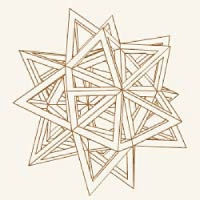Shaping up
Leonardo loved to explore the ancient mysteries of Platonic solids. Find out here what they are and how they are assembled.
Click here to read all about Leonardo’s “Platonic” relationships (expand)
The Platonic solids have fascinated the intellectually curious (and
those with little else to do) for several thousand years. Leonardo
returned to them time and again and they seem to have served as a
useful tool for stimulating his thought processes.
For anyone who wasn’t quite paying attention at school on the day the Platonic solids were discussed, we’ll recap.
A
Platonic solid is a three dimensional object formed entirely from
regular polygons, such as triangles, squares or pentagons. Since
ancient times, ie when Plato was about, there have only ever been five,
and even back then top mathematician Euclid was able to prove that
there can never be any more than five. (Anyone who really wants to know
why this is the case should find a good library on a wet afternoon and
look up Book XIII of Euclid’s Elements.)
Plato believed that
four of these solids represented the atomic structure of the classical
elements (fire, earth, air and water). Although he was mistaken, some
of them are, in fact, the same shape as certain crystals. Sodium
chloride (table salt) has crystals which are cube shaped, calcium
fluoride crystals come in the form of octahedra while pyrite crystals
grow into dodecahedra.
< Back to list

